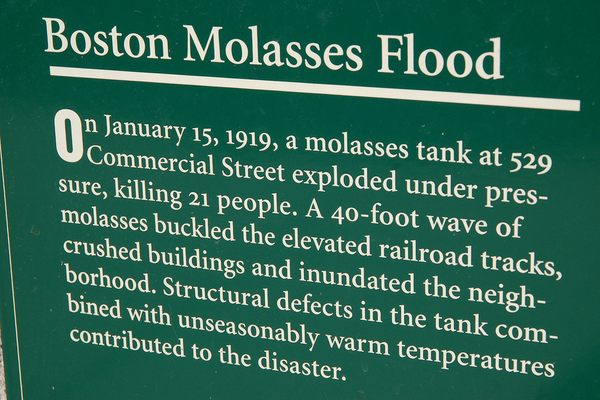100 Wonders: The Great Boston Molasses Flood
In 1919 a wave of molasses traveling at 35mph destroyed an entire neighborhood.
In Boston’s industrial North End is a small, easy to miss plaque memorializing a very strange moment in Boston’s history: the Great Boston Molasses Flood, in which a sugary tidal wave wreaked deadly destruction on the city.
In January 1919, the Purity Distilling Company, located at 529 Commercial Street, was in the molasses business—in a nefarious way. Rather than using the sticky substance for dessert-friendly syrup, the company had taken to fermenting it to make booze and bombs. In a desperate race to turn this sweet sticky stuff into booze before Prohibition hit in January 1920, the company had filled its largest holding tank with as much molasses as it could get its hands on.
This tank was a five-story-tall metal cylinder, 90 feet in diameter and filled to capacity. When it burst, a two-story-tall wave containing 2.3 million gallons of molasses issued forth, traveling out in all directions like a shockwave. Molasses spread across the city at an estimated 35 miles per hour. And it wasn’t just the sugary tidal wave that was so deadly; the tank was ripped into sharp projectiles and shot metal bolts from its sides like bullets.
As the wave and debris crashed down Commercial Street, buildings were smashed to bits. Some were picked up by their foundations and floated away in the tide of molasses. Electrical poles keeled over, exposing live wires. A steel elevated train support beam was torn to smithereens. The elevated train just barely missed being knocked off the tracks, and only through the quick work of the driver was the next train warned that there was no longer a track to run on. Molasses covered everything. According to a Boston Post article, “Horses died like so many flies on sticky fly paper.” It wasn’t just horses. The Great Boston Molasses Flood killed 21 people.
The disaster caused over $100 million of damage in today’s money. In addition to the 21 killed, 150 were injured. Molasses made finding the dead extremely difficult. The final body wasn’t found and pulled from the water under the Commercial St. Wharf for nearly four months.
It took weeks to remove the molasses from the surrounding streets and houses, and the area was said to have remained sticky to the touch for years afterward. While the molasses flood took many lives and destroyed a neighborhood, you would never know it today—save for the flimsy little sign on Commercial Street. Despite its lack of grandeur, it is worth seeking out, for no other reason than to stand and contemplate what was once America’s strangest disaster scene.























Follow us on Twitter to get the latest on the world's hidden wonders.
Like us on Facebook to get the latest on the world's hidden wonders.
Follow us on Twitter Like us on Facebook